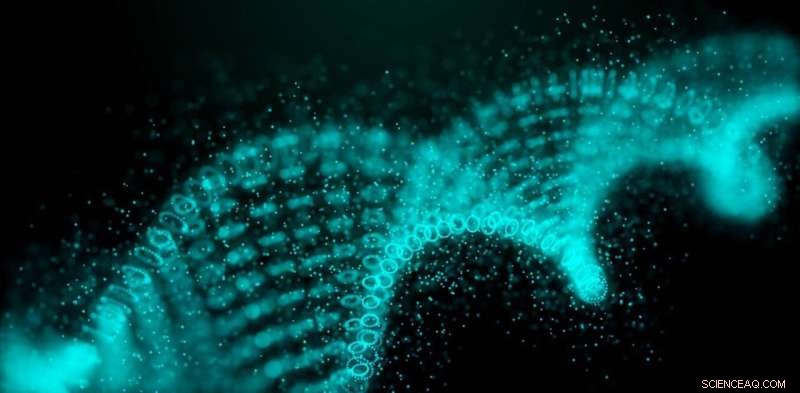
Crédito:thinkhubstudio/Shutterstock
El perfil de ADN aparece con frecuencia en las noticias. El interés público se despierta cuando se utiliza el ADN para identificar a un sospechoso o restos humanos, o se resuelve un caso sin resolver que parece casi olvidado.
Muy de vez en cuando, es en los medios cuando el proceso no funciona como debería.
Entonces, ¿qué es el perfil de ADN y cómo funciona, y por qué a veces no funciona?
Una breve historia de los perfiles de ADN
El perfil de ADN, como se conoce desde 1994, se ha utilizado en el sistema de justicia penal desde finales de la década de 1980 y originalmente se denominó "huellas dactilares de ADN".
El ADN de cada ser humano es muy similar; de hecho, hasta un 99,9 % idéntico. Pero curiosamente, alrededor del 98 % del ADN de nuestras células no está relacionado con los genes (es decir, no tiene una función conocida).
Este ADN no codificante se compone principalmente de secuencias de las cuatro bases que forman el ADN de cada célula.
Pero por razones desconocidas, algunas secciones de la secuencia se repiten:un ejemplo es TCTATTCTATCTATCTATCTA donde la secuencia TCTA se repite cinco veces. Si bien la cantidad de veces que se repite esta secuencia de ADN es constante dentro de una persona, puede variar entre personas. Una persona puede tener 5 repeticiones pero otra 6, 7 u 8.
Hay una gran cantidad de variantes y todos los humanos caen en una de ellas. La detección de estas repeticiones es la base de los perfiles de ADN modernos. Un perfil de ADN es una lista de números, basada en las secuencias repetidas que todos tenemos.
El uso de estas secuencias repetidas cortas (el término técnico es "repetición corta en tándem" o STR) comenzó en 1994 cuando el Servicio de Ciencias Forenses del Reino Unido identificó cuatro de estas regiones. La posibilidad de que dos personas tomadas al azar en la población compartiesen los mismos números repetidos en estas cuatro regiones era de aproximadamente 1 en 50 000.
Ahora, la cantidad de secuencias repetidas conocidas se ha expandido enormemente, con la última prueba analizando 24 regiones STR. El uso de todas las regiones STR conocidas da como resultado una probabilidad infinitesimalmente pequeña de que dos personas aleatorias tengan el mismo perfil de ADN. And herein lies the power of DNA profiling.
How is DNA profiling performed?
The repeat sequence will be the same in every cell within a person—thus, the DNA profile from a blood sample will be the same as from a plucked hair, inside a tooth, saliva, or skin. It also means a DNA profile will not in itself indicate from what type of tissue it originated.
Consider a knife alleged to be integral to an investigation. A question might be "who held the knife"? A swab (cotton or nylon) will be moistened and rubbed over the handle to collect any cells present.

Swabbing an item left at a crime scene can easily yield enough cells to generate a DNA profile. Credit:Fuss Sergey/Shutterstock
The swab will then be placed in a tube containing a cocktail of chemicals that purifies the DNA from the rest of the cellular material—this is a highly automated process. The amount of DNA will then be quantified.
If there is sufficient DNA present, we can proceed to generate a DNA profile. The optimum amount of DNA needed to generate the profile is 500 picograms—this is really tiny and represents only 80 cells!
How foolproof is DNA profiling?
DNA profiling is highly sensitive, given it can work from only 80 cells. This is microscopic:the tiniest pinprick of blood holds thousands of blood cells.
Consider said knife—if it had been handled by two people, perhaps including a legitimate owner and a person of interest, yet only 80 cells are present, those 80 cells would not be from only one person but two. Hence there is now a less-than-optimal amount of DNA from either of the people, and the DNA profiling will be a mixture of the two.
Fortunately, there are several types of software to pull apart these mixed DNA profiles. However, the DNA profile might be incomplete (the term for this is "partial"); with less DNA data, there will be a reduced power to identify the person.
Worse still, there may be insufficient DNA to generate any meaningful DNA profile at all. If the sensitivity of the testing is pushed further, we might obtain a DNA profile from even a few cells. But this could implicate a person who may have held the knife innocently weeks prior to an alleged event; or be from someone who shook hands with another person who then held the knife.
This later event is called "indirect transfer" and is something to consider with such small amounts of DNA.
What can't DNA profiling do?
In forensics, using DNA means comparing a profile from a sample to a reference profile, such as taken from a witness, persons of interest, or criminal DNA databases.
By itself, a DNA profile is a set of numbers. The only thing we can figure out is whether the owner of the DNA has a Y-chromosome—that is, their biological sex is male.
A standard STR DNA profile does not indicate anything about the person's appearance, predisposition to any diseases, and very little about their ancestry.
Other types of DNA testing, such as ones used in genealogy, can be used to associate the DNA at a crime scene to potential genetic relatives of the person—but current standard STR DNA profiling will not link to anyone other that perhaps very close relatives—parents, offspring, or siblings.
DNA profiling has been, and will continue to be, an incredibly powerful forensic test to answer "whose biological material is this"? This is its tremendous strength. As to how and when that material got there, that's for different methods to sort out.